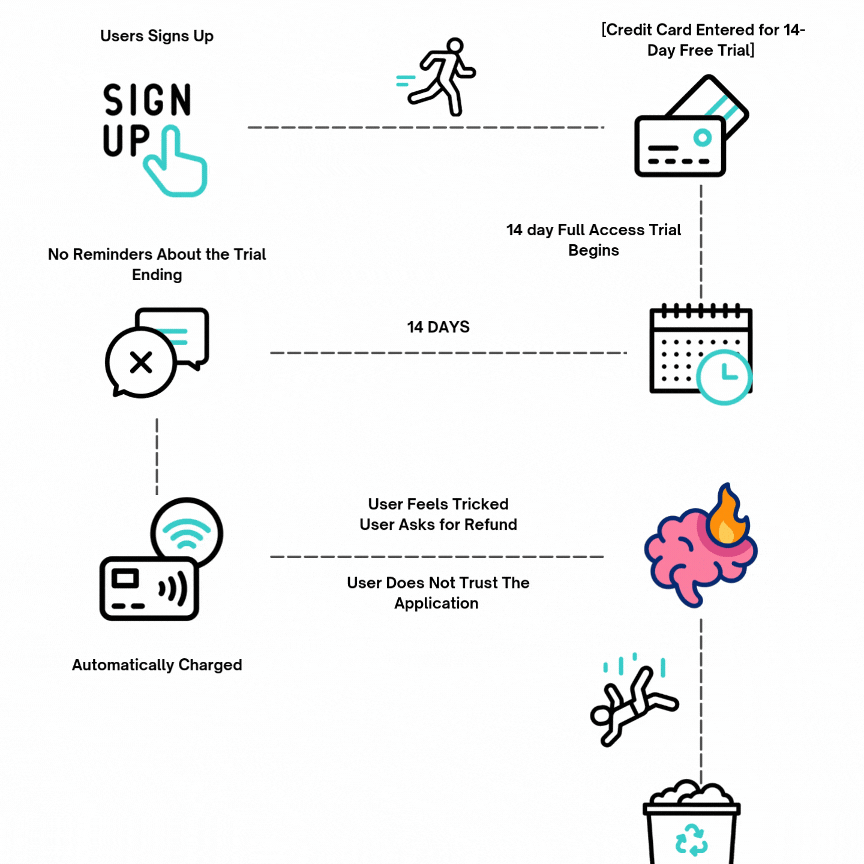Building Trust and Retention for an Advanced Fintech Application
Ardavan Hp
Executive Summary
This case study examines the transformation of an advanced finance management application for a leading US-based fintech startup. Faced with low sign-up rates, negative reviews, and poor retention, we redesigned the trial sign-up flow using ethical dark patterns and improved UX writing. The strategy rebuilt user trust and significantly boosted engagement and retention.
Introduction
As a UX Designer specializing in ethical dark patterns, I was approached by a US-based fintech startup after they found my Udemy course on the topic. They needed a comprehensive UX audit to address trust and retention issues in their advanced finance management application.
Project Overview
The application offers robust budgeting, investment tracking, and expense management. However, the trial model forced users to enter credit card info up front, which, combined with insufficient reminders, led to distrust, unexpected charges, and negative sentiment.
Challenges
- Low Sign-Up Rates: Users hesitated to provide credit card info, stalling trials.
- Negative Reviews: Unexpected post-trial charges triggered refunds, poor app ratings.
- Low Retention: Distrust from the trial model led to high churn.
- Client Constraints: The client insisted on retaining a credit-card-required trial model.

Current User Flow
The existing trial flow was the main source of user dissatisfaction. The flow required immediate credit card info for a 14-day trial, without proper reminders or easy cancellation, prompting distrust.

UX Design Considerations
- Transparency: Communicate trial terms (duration, billing) clearly.
- User Control: Allow easy cancellation before trial ends.
- Ethical Dark Patterns: Use self-deprecating confirmshaming to guide behavior without manipulation.
- Proactive Communication: Send reminders of upcoming charges, empowering user decisions.
- Effective UX Writing: Provide empathetic, clear messaging across the user journey.
- Feedback Mechanisms: Let users share concerns, fostering trust and iterative improvement.
Solution
- Redesigned Trial Flow: Clear terms, explicit consent for future charges, highlighting “no charge unless confirmed.”
- Automated Reminders: Multiple alerts before trial ends, with empathetic language and cancellation options.
- User Confirmation Step: Mandatory opt-in to continue, ensuring users knowingly proceed post-trial.
- Ethical Confirmshaming: Self-deprecating approach in cancellation flows (“We’re sorry to see you go. How can we improve?”).
- Enhanced UX Writing: Clear, transparent, empathetic copy across the entire user journey.
- Transparent Refund Process: Streamlined refunds to reduce frustration and build trust.
Redesigned User Flow
The new flow emphasizes transparency, user control, and ethical dark patterns to rebuild trust. Below is the updated diagram showcasing the improved trial and subscription management process.
Implementation Details
- UX Audit: Identified pain points in the existing flow.
- Email Campaigns: Automated reminders prior to charge, ensuring user awareness.
- UX Writing: Empathetic, clear copy ensuring transparency and user-centric messaging.
- Ethical Dark Patterns: Self-deprecating confirmshaming without user manipulation.
- Feedback Integration: Channels for user feedback and continuous improvement.
.gif)
Outcomes
- +19% Sign-Ups: Surge in registrations post-launch.
- Enhanced Trust: Transparent practices fostered a stronger sense of security.
- Improved Retention: Respectful, clear trial management increased user loyalty.
- Better Reputation: Fewer negative reviews, more positive word-of-mouth referrals.
- Lower Churn: Addressed root dissatisfaction, stabilizing the user base.
- Increased Revenue: More conversions post-trial, fewer refunds.
Conclusion
By strategically overhauling the trial sign-up process with ethical dark patterns, transparency, and user control, the fintech application tackled trust barriers and boosted engagement. This underscores the importance of user-centric design and honest communication in creating sustainable growth and loyalty, especially in the highly competitive fintech market.


